Usually designed for woodworking, belt sanders also handle other materials such as plastic or metal. But between sanders geared towards professionals and those designed for the general DIYer, it's not easy to make a choice. So to help you in your quest for the best belt sander, follow this guide.
Here is our commitment, to make sure that we provide the best user experience and content quality:
You can support us by using our links to make your purchases (at no extra cost to you)! This sometimes earns us a commission which allows us to remain independent. More about us
Our selection
"With a power of 750 W, the belt sander PBS 75 AE is ideal for precision work. Its dimensions and weight give it a compact…"
"With a very attractive price, the Skil 1215AA is a perfect tool for stripping and sanding jobs. Easy to handle, it offers a speed range…"
"Robust and handy, the Makita 9403 performs with a 1200 W motor offering a speed up to 500 m/min. With a belt size of 100…"
"With a 940 W motor and a wide belt, the Makita M9400 is perfect for sanding large surfaces. Attractive in its size and ergonomic design,…"

With a power of 750 W, the belt sander PBS 75 AE is ideal for precision work. Its dimensions and weight give it a compact appearance for optimal handling.
111 £ on AmazonThe Bosch belt sander - PBS 75 AE combines high performance with a high level of user comfort. The machine is equipped with a 750 W motor that can offer a speed of 200 to 350 meters per minute. The Bosch sander even has an electronic speed control that can be adjusted via a preselection wheel to suit all types of materials. Featuring improved ergonomics with a compact design, the machine offers a 76 x 165 mm sanding surface with a 75 x 533 mm belt. For ease of handling, the tool takes a weight of 3.5 kg.
It ensures fast sanding progress on large flat surfaces and even for the most demanding sanding projects. The sander is also suitable for painted surfaces, varnished surfaces or for pre-sanding beams and other rough surfaces. To ensure optimal results, the sanding tool includes an automatic centering system to keep the belt in the right position during sanding. The unit also includes an SDS lever clamp for easy belt change.
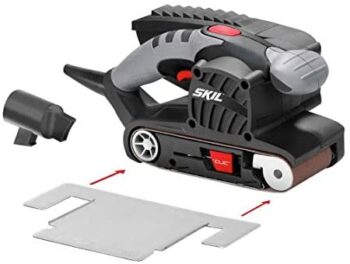
With a very attractive price, the Skil 1215AA is a perfect tool for stripping and sanding jobs. Easy to handle, it offers a speed range of 300 m/min with belt dimensions of 76 x 457 mm.
59,20 £ on AmazonErgonomic and very practical, the Skill 1215 AA belt sander is a device designed for restoration or DIY. It is equipped with a sanding frame called "equalizer" for perfect precision during use. To maintain the stability and position of the belt, the sander is equipped with an automatic centering system "ABC". Easy to use with two hands, it has a bi-material handle with a click system to facilitate a quick change of accessories.
With a weight of 2.9 Kg, the device has a length of 34.5 cm with 17.4 cm wide and a height of 15.7 cm. Its reduced size and its light weight allow a great handiness and practicality in use. Powered by 240 V, the belt sander has a power of 650 W propelling a speed up to 300 m/min. To ensure its sanding capabilities, the device has a sanding surface of 76 x 130 mm with a sanding belt of 76 x 457 mm allowing it to adapt to any form of material.
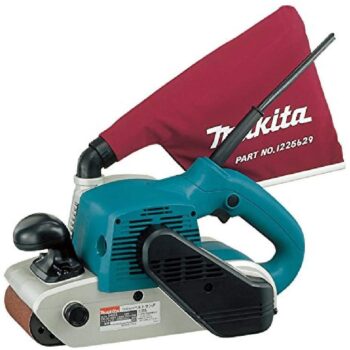
Robust and handy, the Makita 9403 performs with a 1200 W motor offering a speed up to 500 m/min. With a belt size of 100 x 610 mm, it is completely adapted for intensive sanding.
219 £ on AmazonIdeal for professionals and rather recommended for experienced DIYers, the Makita 9403 belt sander is a very powerful tool suitable for intensive sanding. Robust and powerful, the machine is equipped with an aluminum housing with a power of 1200 W. Perfectly manageable with its weight of 5.7 kg, the machine is powered at 240 V via a 5 m long electric cable allowing the user to have a significant freedom of movement.
At its performance, the sander develops a speed up to 500 m/min with dimensions of a sanding belt of 100 x 610 mm. Apart from an excellent power ratio, it is equipped with an automatic belt centering for a precise and efficient work. The device is equipped with a dust collection bag to keep the work surface clean. The sander is even equipped with an adapter to take care of and allow to be connected to a vacuum cleaner to limit dust.
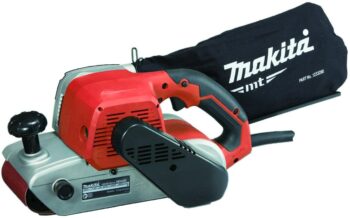
With a 940 W motor and a wide belt, the Makita M9400 is perfect for sanding large surfaces. Attractive in its size and ergonomic design, it is also effective in stationary mode.
133 £ on ManomanoAny specific needs?
The best entry-level belt sander
Your guide :
Rate this buying guide :By rating this buying guide, you are helping us to reward our best writers. Thank you!
| The Best | Inexpensive | Top of the line | Excellent | |

In accordance with our commitment, this buying guide does not contain any sponsored products. |
 8/10 |
 7/10 |
 9/10 |
 8/10 |
| OUR SELECTION |
Bosch Belt Sander - PBS 75 AE Edition Set
|
Skil 1215AA Belt Sander
|
Makita Belt Sander 9403
|
Ponceuse à bande Makita M9400
|
|
With a power of 750 W, the belt sander PBS 75 AE is ideal for precision work. Its dimensions and weight give it a compact appearance for optimal handling.
|
With a very attractive price, the Skil 1215AA is a perfect tool for stripping and sanding jobs. Easy to handle, it offers a speed range of 300 m/min with belt dimensions of 76 x 457 mm.
|
Robust and handy, the Makita 9403 performs with a 1200 W motor offering a speed up to 500 m/min. With a belt size of 100 x 610 mm, it is completely adapted for intensive sanding.
|
With a 940 W motor and a wide belt, the Makita M9400 is perfect for sanding large surfaces. Attractive in its size and ergonomic design, it is also effective in stationary mode.
|
|
|
Power
|
750 watts
|
650 watts
|
1200 watts
|
940 watts
|
|
Speed
|
200 to 350 m/min
|
300 m/min
|
500 m/min
|
380 m/min
|
|
Sanding belt size
|
75 x 533 mm
|
76 x 457 mm
|
100 x 610 mm
|
100 x 610 mm
|
|
Weight
|
3.5 kg
|
2.9 kg
|
5.7 kg
|
6.2 kg
|
|
Dimensions
|
49.2 x 36.8 x 12.6 cm
|
34.5 x 17.4 x 15.7 cm
|
35.3 x 16.4 x 21.1 cm
|
35.4 x 17.5 x 16.9 cm
|
Help us improve this table:
Report an error, request the addition of a feature to the table, or suggest another product. Thank you for your kindness!
We spend thousands of hours each year studying the major specialized websites, analyzing products of hundreds of brands and reading user feedback to advise you on the best products.
We are a product review company with a single mission: to simplify your buying decisions. Our research and testing helps millions of people every year find the best products for their personal needs and budget.
To support us you can: use our links to make your purchases (which often earns us a small commission), share our articles on social networks, or recommend our site on your blog. Thanks in advance for your support!
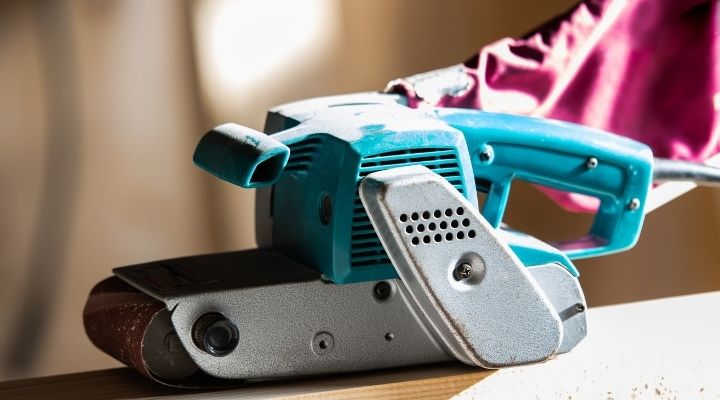
The power of a belt sander varies from one model to another and will be defined according to your needs when choosing your tool. The power affects the efficiency and quality of the sanding.
However, it is recommended to choose a sander with at least 500 watts to be satisfied with the quality of the final result.
You should know that a powerful belt sander allows you to work on all types of materials and to obtain quality finishes. Less powerful models will only allow for wood work in softer, fairly small projects.
This criterion will determine how fast your sanding tool is and what type of material it should be used on. For the most part, the unit of measurement is defined by meters per minute or m/min and on some brands, it even advertises the speed of the rollers indicated in revolutions per minute or rpm.
The size of the sanding belt is a non-negligible aspect that presents itself more than essential when purchasing your tool. Indeed, the belt is the accessory that allows you to sand in full efficiency and that will define the sanding surface of your device.
The size of the belt will be determined by its width and length. The larger these are, the faster the sanding job will be. A larger belt size will also allow less lateral movement with shorter passes.
In general, the sanding belt width on the market varies from 75 to 100 mm with lengths ranging from 450 to 650 mm.
The ergonomics of your belt sander will define its maneuverability as well as the comfort of use. At this level, it will be mainly conditioned by its weight and its handles for a better grip and ease of use. The weight of your tool will also determine its efficiency and maneuverability.
As for a sander, a model with a heavy weight will be more adapted and stable on more solid materials such as a wooden floor finish. On the other hand, for less solid materials, a light sander will be much more convenient. In general, the best belt sanders available on the market range from 2.5 to 9 kg. Your choice will then depend on the job you plan to do.
For even more comfort and an optimal grip, it is crucial to question the handles of your belt sander. The handles will offer grip and help minimize fatigue during use. It also allows you to hold the tool firmly and guide it with great simplicity and efficiency.
Sanding generates a lot of dust and debris. Choosing a belt sander with a dust extraction system will be an asset to your choice of device. This option will allow for a relatively clean environment and work surface. It will also contribute to the precision and optimization of the final result by having a better vision on the sanding progress.
The dust extraction system will also allow you to preserve yourself from the harmful effects of the particles of certain materials while sparing your eyes, lungs and skin. This dust management system varies according to the models of belt sanders. In general, sanders adopt a filtration system as well as an integrated vacuum cleaner. Some models evacuate the dust to a removable dust bag and others integrate a recovery cartridge.
However, there are models that are compatible directly with a conventional or construction vacuum cleaner by removing the dust bag.
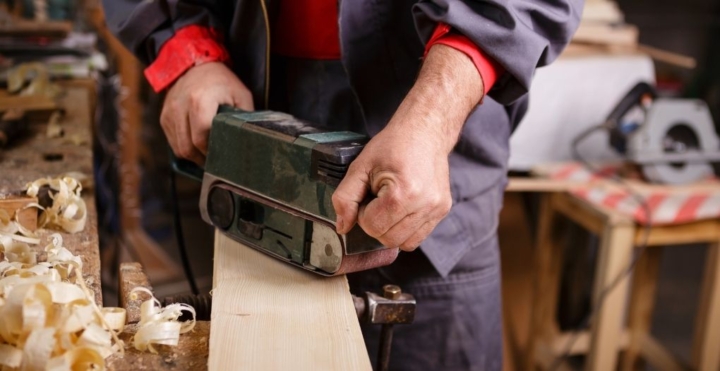
The belt sander is a handy, powerful and versatile DIY tool. It is designed for both small jobs and large-scale projects. Opting for a belt sander allows for better performance while still allowing for a quality finish. But for this, it is necessary to achieve proper use.
.To do this, it's always essential to read the user manual that came with your tools to learn more about its parts, components and supported aspects.
When it comes to a belt sander, there are specific steps to follow for optimal use since it is a relatively heavy and very powerful device.
But beware, using a belt sander requires a firm two-handed grip without the need to lean on the tool given its power and weight. It is only a matter of turning it on and applying it by positioning it on the material with back and forth movements following the direction of the wood fibers. It should be noted that the types of sanding belts to be used will depend on the work.
Note that the removed materials can accumulate on the sanding belt and decreases the sanding efficiency. At this point, you will be in the position of having to change the belt to continue working and have satisfactory results.
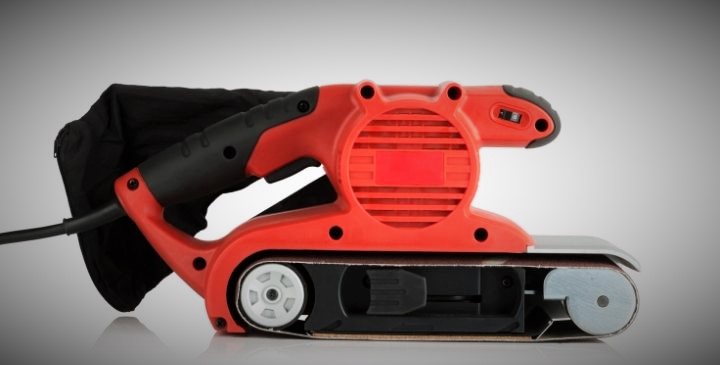
It is an equipment with a sanding system working like a conveyor belt. It consists of two rollers connected by an abrasive belt rotating around these two elements. This type of belt sander is mainly designed to work on large flat surfaces and for stripping and roughing work.
These machines have a high power rating ranging from 500 to 1200 watts to ensure intensive work. They are also capable of polishing and sanding different materials such as paint or varnish.
Some models are equipped with variable speeds and a dust management system to ensure versatility and ease of use. These portable sanders are ideal for small projects or large areas such as decks to smooth and finish surfaces. The most commonly used belts on handheld sanders are the 75 x 533 mm, 76 x 457 mm and 100 x 610 mm sanding belts.
The disadvantages of this type of belt sander are that it is rather heavy and can only be used in back and forth motions causing large dust clouds. These sanders are not dedicated for high precision work given their size and weight.
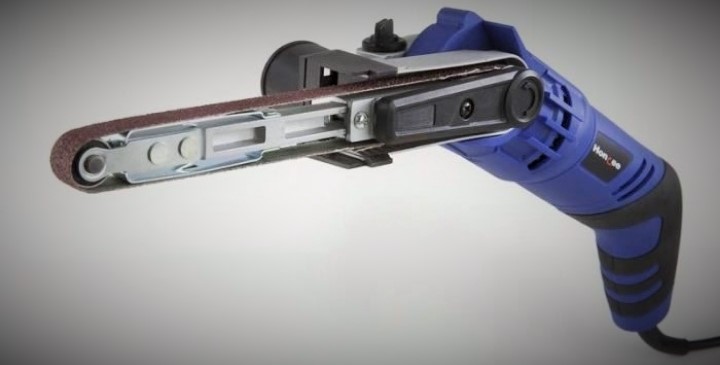
Functioning on the same principles as a roller belt sander, belt files are generally portable sanders that use narrow, small sized abrasive belts. They are a smaller version with a lighter appearance offering more maneuverability and flexibility.
These machines are ideal to fit into tight work spaces and reach inside corners. In fact, these sanders are designed for finishing irregular areas in narrow and cramped areas with a clean and polished look. The current dimensions of its belts vary from 12,7 x 457 mm, 9,5 x 330 mm and 12,7 x 610 mm.
Although it is a precision tool, at its default, this sander will be limited to small projects or jobs that only require sanding of specific sections. It will not be suitable for large, intensive sanding jobs.
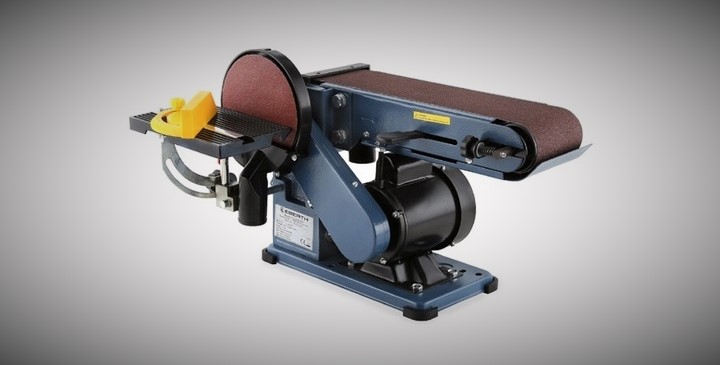
Stationary belt sanders can be mounted on a bench, pedestal, or even on large machines with their own stand. They can also be used in series.
These machines are designed in different ways and use different belt sizes depending on the application. Some professional models are used in specialized fabrication shops or large manufacturing facilities. The most common belt sizes for the stationary belt sander range from 25.4 x 762 mm, 50 x 1828 mm, 100 x 915 mm and 152.4 x 1220 mm.
These machines often have a built-in disc sander that uses the same motor as the belt pulley. These types of equipment are commonly referred to as combination belt sanders and are well known in cabinetry and small woodworking. They are primarily used for detailed work on small objects or sharpening tools.
Examples include keeping tools sharp, smoothing the edges of small pieces of wood and plastic, or performing manual and craft work.
The belt sander is characterized by its two parallel rollers on which an abrasive belt is stretched. It is used only from front to back with a great capacity to perform a coarse, fast and very efficient sanding.
The rollers are driven by a motor and the sanding belts are coarse, medium or fine grit depending on the work to be done. In general, it has a variable sanding width of 75 to 100 mm depending on the device. The sanders with small sanding belt widths ranging from 9 to 13 mm are the electric files.
Quite heavy for an electroportable tool, it weighs in the 3 to 8 kg with a power ranging from 500 to over 1000 watts depending on the model. It is especially adapted to the work of roughing and stripping of very large surfaces such as a parquet floor, a partition or even beams. It will be especially effective for working on very rough surfaces in a horizontal and flat position.
This type of sander is not recommended for finish sanding. Coarse grit sanding belts are used for roughing, medium grit for intermediate sanding and fine grit for finishing. Given its great power, it should be noted that the belt sander is a rather noisy tool and gives off a lot of dust.
The eccentric or orbital sander is equipped with a round plate on which an abrasive disc is fixed. It is a multi-purpose power tool designed for sanding parquet, doors, tables, chairs, beams or shutters.
It is rather intended for stripping work to the finish. The eccentric sander is characterized by a flexible rubber sole that allows it to work on curved or curved surfaces. It operates in circular, eccentric, rotary and oscillating movements. This sander has the particularity of allowing precision work with both stripping and finishing such as polishing or buffing.
In general, these sanders are equipped with motors with variable power from 300 to 800 watts that can develop a rotation speed ranging from 4000 to 10000 rpm depending on the model. Its weight will vary from 900 grams to 4 kg with diameters of abrasive discs ranging from 90 to 225 mm depending on the plate of the device.
With a fairly light weight, some models of eccentric sanders are compatible with telescopic handles for sanding at height. This type of sander will be mainly oriented to work on flat and curved surfaces but will not be suitable for corners and angles because of its round shape.
The choice of a sander will depend on the work and the intervention that you plan to do. Both the belt sander and the eccentric sander have advantages and limitations to their uses. If you are planning intensive, large-scale work on flat surfaces, the belt sander will be your best ally.
But if your project is geared toward less intense sanding and polishing work even on curved and domed surfaces, the eccentric or orbital model will be the better option.

The belt sander is an electrically powered do-it-yourself device that has multiple advantages in use. These advantages will be defined according to specific needs, but all belt sander models have common advantages.
Versatility
The belt sander is a very versatile sander that allows for both rough sanding and optimal finishing. It can also work on different types of materials such as wood, plastic and metal. This type of sander has several functions such as stripping, sanding or polishing. These are very practical and indispensable in DIY.
Power
The belt sander is a tool that has the reputation of being very powerful compared to other types of sanders. This will allow it to cope with intense work and offer great efficiency and robustness on all types of surfaces, even the roughest. It should be noted that because of this power, the device requires a two-handed grip for greater safety and better handling.
Ergonomics and practicality
Powerful DIY tools often tend to be difficult to handle. In the case of the belt sander, this problem is made up for by a heavy enough weight to provide stability with the availability of two handles for better maneuverability. Its weight will also save you from having to use a large support force when sanding. Indeed, for a good control and an excellent guidance of the device, it is essential to have a two-handed grip.
Fast action
Belt sanders are powerful and very aggressive machines that can sand and remove a lot of material from large surfaces in a very short time. Very efficient to use, these sanders save you a lot of time and physical effort. Some do-it-yourselfers use them to start their sanding jobs that require large-scale sanding in a short period of time.
Dust extraction management
Most belt sanders are equipped with dust extraction systems or removable dust bags. This system will protect you from the harmful effects of dust and keep your work surface clean. It also contributes to the progress and quality of sanding by having a better perspective on the work with a clear sanding area. The dust extraction system will also save time on cleaning up after your sanding work is completed.
In our opinion, the best brands of belt sanders in 2022 are :
Founded in 1886, the Bosch brand is a German multinational that is ranked among the leaders in many sectors. It has made its reputation in the DIY world for its different types of saws, drills and sanders. As far as Bosch belt sanders are concerned, they are well known for their efficiency, their performance and especially for their durability.
The brand evolves in innovation combined with its know-how in order to satisfy the DIYers and its users. The reputation of the Japanese brand is mainly linked to high-end products with outstanding qualities at cheaper prices. Highly efficient and also suitable for intensive sanding, Makita belt sanders are both for general public, professionals and even in the industrial field.
The Skil brand starts its history in 1924 with the invention of the first electric circular saw. Today, it specializes in the manufacture of various types of electroportable tools. Of American origin, Skil belt sanders are the result of extensive research to ensure their efficiency and quality while having safe and simple to use aspects.
Originally German, the Einhell brand was founded in 1964 and went public in 1987. The brand progresses in the manufacture and sale of tools, accessories and materials in the field of DIY as well as gardening. Einhell belt sanders stand out for their reliability and ease of use.
Founded in 1923, the German brand Metabo has its roots in the invention of the first hand drill. The name Metabo comes from this invention and from the word meaning metal drill. Today, the brand evolves in the sale and manufacture of professional power tools. Its belt sanders are known for their power and their great qualities to adapt to all intensive and professional works.
The diagram below will help you to get an idea of the typical prices for each price range (entry-level, mid-range and high-end).
However, more expensive does not necessarily mean better.
We therefore advise you to always consult our ranking before deciding, rather than blindly relying on price ranges.
Maintaining your belt sander
The belt sander is a power tool that requires regular and proper maintenance to maintain its performance with each use. You should also know that maintenance will promote a long life for your machine.
Generally, the manuals that come with your belt sander include instructions for disassembly and tips for cleaning the components. Maintaining your machine is basically getting rid of the chips and dust that get into the internal components. It will also be a matter of replacing faulty accessories.
For cleaning you will use a dusting device such as a blower or a vacuum cleaner. The abrasive belts, however, will be maintained with an abrasive stick after each use. Also check the condition and alignment of the rollers to avoid uneven belt wear. The motor valve should also be checked and cleaned to guard against overheating during use.
Types of sanding belts for each type of material to be sanded
The sanding belts to fit on your belt sander will depend on the type of project and result you want to achieve. Let's start with the different sanding belts that are designed for different types of material.
For sanding wood and removing paint from a surface, a sandpaper or corundum type sanding belt is best. Plasters and varnishes will be better suited to anti-sanding papers. Interior coatings or plaster will also have quality sanding with reversible sanding belts.
As for plastics, corundum paper will be the best option, while for metals, your belt sander will offer optimal results with a corundum or emery cloth belt.
Grain size of a belt for each stage of use
When sanding, it is also necessary to adapt the size of the belt grains at each stage of use to have a more suitable rendering and save more time when using your sander.
To start sanding on a surface, it will be more suitable with a sanding belt with a grit size between 35 and 40. To remove material, grit sizes between 40 and 60 will provide a more effective sanding. For roughing, the grit size of the belt will be more suitable from 60 to 80. For standard or conventional sanding, the belt grit size will range from 80 to 120.
And for finishing jobs, it will be more advantageous with a belt grit size ranging from 120 to over 240.
Changing the sanding belt on your belt sander
Mostly, the instructions for changing the sanding belt are mentioned in the manual that comes with the tool. In case you do not have these instructions in hand, it will be necessary to follow a few steps to complete this procedure.
To begin with, make sure the unit is actually turned off or unplugged altogether. Then, try to lower the tension of the belt on the rollers with a lever or mechanical arm located on the side, usually on the right side of the machine. Once the tension of the belt is lowered, you can easily remove the belt to replace it with another one and tighten it again on the rollers of the machine with the same mechanical lever.
In general, some belt sanders are equipped with a knob that allows you to center the belt, others will adopt an automatic centering system.
Safety rules for a belt sander
A prior to handling a belt sander, it is important to consult the operating instructions mentioned in the manufacturer's manual that comes with your tool. It will also be necessary to understand how it works and the types of jobs designed for the device.
Secondly, as with some types of DIY work, it will be essential to use safety equipment such as goggles, gloves and a mask as well as hearing protection if necessary. Then, before starting to sand, remember to prepare and secure the material to be sanded if it is a moving part.
Don't forget that before removing any components from your sander, it is mandatory to ensure that it is turned off and unplugged. Whether it's to change the sanding belt or to remove and empty the dust collector. And for added safety when sanding non-ferrous metal materials, be sure to dispose of sawdust and wood waste in the dust bag.
A belt sander is a power tool with an abrasive belt. It is a device that can be dangerous if used in the wrong way. It is a handy tool for sanding large areas and it is powerful as you can find machines starting at 500 or 700 watts. To summarize, make a checklist of all the accessories to check their condition. Then, if you are new to using a belt sander, let the weight of the machine do the work.
For better conditions in use and to maintain the performance of its belt sander, it is important to maintain it and check the condition of the mechanical elements. Given the power and speed of this type of tool, it is recommended to always check the condition of the belts by determining if it shows some aspects of deterioration after several uses. The condition of the rollers may also wear out over time. It will therefore be necessary to replace the failing elements to ensure the proper functioning of your tool.
In the event that your tool's belt fails, it will need to be replaced. To do so, it is imperative to choose a model that corresponds, exactly, to the brand of your belt sander. To do this, visit the manufacturer's website or go to a specialized store and ask for advice so as not to damage your tool.
Well known to do-it-yourselfers, a belt sander is defined as a very versatile device. Many think that when referring to a sander, it will be mostly about sanding wood. But you should also know that the belt sander is intended to be applied to all types of materials from laminated wood to plastic, fiberglass, ceramic, or even aluminum and metal.
To remove surface paint with a belt sander, you need to mount a coarse grit sanding belt on a belt reference between 35 to 60. When applying, run the sander flush with the paint to be removed so as not to damage the surface under the paint. This system will scratch and remove as much paint as possible. Afterwards, if you want a smooth surface, you will have to replace the sanding belt with another one with finer grains depending on the result you are looking for.
Every month we help more than 1 000 000 people buy better and smarter.
Copyright © 2022 - Made with ♥ by buyingbetter.co.uk
Your reviews and buying guides 0% advertising, 100% independent!